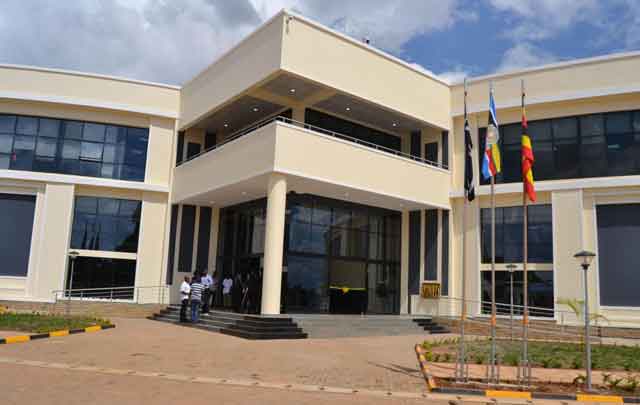
Kampala, Uganda | THE INDEPENDENT | It is seven months since, President Yoweri Museveni, commissioned the National Closed Circuit Television – CCTV Command Centre based at Naguru police headquarters. But the public had never been granted the chance to tour and assimilate with what is done inside.
On a bright afternoon, a Uganda Radio Network –URN journalists tags along with a team of visitors who wanted to assimilate themselves with what transpires inside. Police force’s ICT director Commissioner of Police –CP Felix Baryamwisaki receives the visitors on stairs at the entrance.
Baryamwisaki quickly informs them that no cameras should go beyond the reception and that no one would be allowed to take pictures inside the crucial security rooms. Everyone had to keep their phones in their pockets.
About 10 metres from the reception, Baryamwisaki leads visitors into the crime monitoring room at the right turn. This room is managed by a team of over 30 non-commissioned policemen and women. In there, is a big screen capturing all areas within Kampala metropolitan hanged on a wall.
Even though all places within the city centre are monitored, the emphasis is put on places with too much crowding among others Kikuubo, Taxi and Bus parks, Kaleerwe Market, Nakasero Market, Usafi Market, Kamwokya and Kisenyi.
The Commander of the Crime Monitoring Unit explains to visitors how all the eighteen police divisions that make up Kampala metropolitan are connected to the National CCTV Command Centre.
“Here we get clear images of individuals, groups of people and cars parked or in motion. If we become suspicious of something, we pull all the cameras within that area. We quickly make an analysis of what we have seen and where necessary we immediately alert the police in that area to take action,” head of the crime monitoring unit explains.
To support his explanation, the commander a Superintendent of Police pulls all cameras along the Gayaza road starting from Kaleerwe, Kanyanya, Mpererwe and Kasangati. At this point, visitors were able to see roads leading to all places off the main road including youth at junctions and trading centres playing cards while others seemed to argue about something.
From the crime monitoring room, Baryamwisaki alongside Chief of Joint Security –CJS Maj Gen Jack Bakasumba, lead the visitors to traffic monitoring where they introduce the unit commander as Assistant Superintendent of Police –ASP Joseph Khisa.
“This is the traffic monitoring centre. These people are the ones who help to regulate traffic. They are the ones who help to identify wanted vehicles,” Baryamwisaki says.
ASP Khisa explains that they have two systems in the traffic monitoring room which run concurrently. The systems include Internal Video Recording System –IVS which records live videos and Number Plate Recognition System-abbreviated as NPR. The NPR system has cameras mounted on roads that take pictures of the vehicle and motorcycle number plates.
“Whenever a vehicle commits an offence and it is nowhere to be seen, we blacklist in our system. When any of the blacklisted vehicles pass, we get a notification and we communicate to police officers ahead. The IVS also monitors traffic flow and advise traffic officers on ground on what to do,” Khisa says.
The traffic monitoring centre is managed by about 15 Police Constables. Adjacent it, there is a call monitoring centre which is managed by more than 20 lower rank policemen and women. This unit is headed by ASP Asiimwe whom CP Baryamwisaki instructs to explain to visitors how the call monitoring unit works.
“When we receive an alert or distress call, the system captures the number telephone line and location of the caller. We alert the dispatch operator [also known as operations room]. An alert is made to the guard branch who are normally police officers in nearby Police Post. The operations room keeps on the incident until feedback is got,” ASP Asiimwe explains.
CP Baryamwisaki adds that the biggest challenge police had before was people calling and police taking long to respond because phones made from India and China would divert customer helplines to police emergency desk.
“We gave our number triple 999 number priority and it is picked in 20 seconds. But when you dial 112, you go through a process of selecting who you want to speak to. If you are not a genuine caller, you hang up. But when you persist we know you’re a true caller,” CP Baryamwisaki explains.
Maj Gen Bakasumba and CP Baryamwisaki afterwards lead the visitors to the Decision-Making room which is on the first floor. Inside the Decision-Making room, there is also a big screen hanged on the wall and over 20 desktop computers where both traffic and crime-related incidents are monitored.
“This is where the Chairman of task force sits and they give orders basing on the need. If they have an area of interest, they do not go to the crime monitoring centre. They do everything according to what they have seen,” CP Baryamwisaki explains.
In the Decision-Making room, you find top security echelons that include senior police, army and crime intelligence officers. The room also serves as COVId-19 operations task force centre which is headed by Maj Gen Leopold Kyanda, Maj Gen Bakasumba and Brig Dr Kyengo.
********
URN
 The Independent Uganda: You get the Truth we Pay the Price
The Independent Uganda: You get the Truth we Pay the Price



